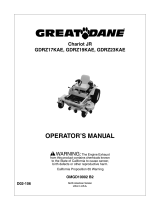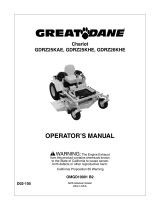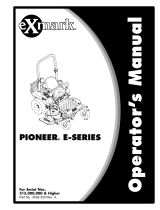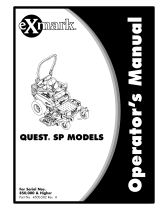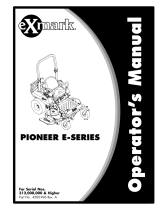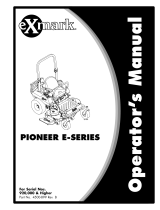Page is loading ...

OPERATORS MANUAL
EP60MX800EV5 EP72BSV37EV5 EP72BSV37EV5RD
EP60FX921V5 EP72MX825EV5 EP72MX825EV5RD
EP72FX1000V5 EP72FX1000V5RD

2
ENCORE MFG.
A DIVISION OF
WORLDLAWN POWER EQUIPMENT, INC.
ENCOREEQUIPMENT.COM
401 COMMERCE STREET
BEATRICE, NE 68310
800-267-4255
FAX – 402-223-4103

3
Contents
AVAILABLE ACCESSORIES ........................................................................................................ 6
SAFETY ...................................................................................................................................... 7
SAFETY ALERT SYMBOL ...........................................................................................................................................7
TRAINING ................................................................................................................................................................7
PREPARATION .........................................................................................................................................................7
OPERATION .............................................................................................................................................................8
SLOPE OPERATION ..................................................................................................................................................9
USING THE ROLLOVER PROTECTION STRUCTURE ............................................................................................... 10
MAINTENANCE AND STORAGE ............................................................................................................................ 10
SAFETY AND INSTRUCTIONAL DECALS ................................................................................................................ 12
SPECIFICATIONS ..................................................................................................................... 15
MODEL NUMBER ................................................................................................................................................. 15
WEIGHT & DIMENSIONS ...................................................................................................................................... 15
ENGINE ................................................................................................................................................................ 15
FUEL SYSTEM ....................................................................................................................................................... 15
ELECTRICAL SYSTEM ............................................................................................................................................ 15
TRANSMISSION .................................................................................................................................................... 15
CUTTING DECK ..................................................................................................................................................... 15
TIRES .................................................................................................................................................................... 15
OPERATION ............................................................................................................................. 16
OPERATOR CONTROLS ......................................................................................................................................... 16
STEERING AND MOTION CONTROL ................................................................................................................. 16
SAFETY INTERLOCK .......................................................................................................................................... 16
CHOKE CONTROL ............................................................................................................................................. 16
THROTTLE CONTROL ........................................................................................................................................ 16
PARK BRAKE LEVER .......................................................................................................................................... 16
FUEL SHUT-OFF VALVE .................................................................................................................................... 17
IGNITION SWITCH ............................................................................................................................................ 17
HOUR METER ................................................................................................................................................... 17
DRIVE WHEEL RELEASE VALVES ....................................................................................................................... 17
DECK LIFT SWITCH ........................................................................................................................................... 17
BLADE ENGAGEMENT SWITCH ........................................................................................................................ 17

4
FULL SUSPENSION SEAT ................................................................................................................................... 18
OPERATING INSTRUCTIONS ................................................................................................... 19
RAISE THE ROLLOVER PROTECTION STRUCTURE (ROPS) ................................................................................ 19
STARTING THE ENGINE .................................................................................................................................... 19
BLADE ENGAGEMENT ...................................................................................................................................... 19
DISENGAGING THE BLADES ............................................................................................................................. 19
STOPPING THE ENGINE .................................................................................................................................... 20
DRIVING THE MACHINE ................................................................................................................................... 20
TRAINING ......................................................................................................................................................... 20
DRIVING FORWARD ......................................................................................................................................... 20
DRIVING IN REVERSE ....................................................................................................................................... 21
ADJUSTING THE CUTTING HEIGHT .................................................................................................................. 21
ADJUSTING THE ANTI-SCALP ROLLERS ............................................................................................................ 21
TRANSPORTING ....................................................................................................................... 22
TRANSPORTING A UNIT ................................................................................................................................... 22
LOADING A UNIT .............................................................................................................................................. 22
MAINTENANCE ......................................................................................................................... 23
RECOMMENDED MAINTENANCE SCHEDULE(S) ................................................................................... 24
CHECK ENGINE OIL LEVEL ................................................................................................................................ 25
CHECK BATTERY CHARGE ................................................................................................................................ 25
RECOMMENDED JUMP-STARTING PROCEDURE ............................................................................................. 26
CHECK MOWER BLADES .................................................................................................................................. 27
CHECK SAFETY INTERLOCK SYSTEM ................................................................................................................. 27
CHECK ROPS ..................................................................................................................................................... 28
CHECK SEAT BELT ............................................................................................................................................. 28
CHECK FOR LOOSE HARDWARE ....................................................................................................................... 28
SERVICE AIR CLEANER ...................................................................................................................................... 28
CHANGE ENGINE OIL ....................................................................................................................................... 28
CHANGE ENGINE OIL FILTER ............................................................................................................................ 28
CHECK HYDRAULIC OIL LEVEL .......................................................................................................................... 29
CHECK TIRE PRESSURES ................................................................................................................................... 29
CHECK CONDITION OF BELTS ........................................................................................................................... 29
LUBRICATE GREASE FITTINGS .......................................................................................................................... 29

5
CASTER WHEEL ROTATION .............................................................................................................................. 29
CHECK SPARK PLUGS ....................................................................................................................................... 30
CHANGE HYDRAULIC SYSTEM FILTER AND FLUID............................................................................................ 30
HYDRAULIC SYSTEM AIR PURGE ...................................................................................................................... 30
THREAD LOCKING ADHESIVES ......................................................................................................................... 31
COPPER-BASED ANTI-SEIZE.............................................................................................................................. 31
DIELECTRIC GREASE ......................................................................................................................................... 31
CASTER PIVOT BEARINGS PRE-LOAD AND LUBRICATION ................................................................................ 31
CHECK V-BELTS ................................................................................................................................................ 32
ADJUSTMENTS ........................................................................................................................ 33
DECK LEVELING ................................................................................................................................................ 33
PUMP DRIVE BELT TENSION ............................................................................................................................ 33
MOWER DECK DRIVE BELT TENSION ............................................................................................................... 34
PARK BRAKE ADJUSTMENT .............................................................................................................................. 34
MOTION CONTROL LINKAGE ADJUSTMENT .................................................................................................... 34
NEUTRAL ADJUSTMENT ................................................................................................................................... 35
MOTION CONTROL DAMPER ADJUSTMENT .................................................................................................... 35
MOTION CONTROL NEUTRAL LOCK PIVOT ADJUSTMENT ............................................................................... 35
MOTION CONTROL HANDLE ADJUSTMENT ..................................................................................................... 36
CLEANING ........................................................................................................................................................ 37
CLEAN ALL DEBRIS FROM ENGINE AND EXHAUST SYSTEM AREA. .................................................................. 37
CLEAN DUST AND DIRT FROM CYLINDER HEAD FINS. ..................................................................................... 37
CLEAN DEBRIS FROM MACHINE ...................................................................................................................... 37
CLEAN GRASS BUILD-UP UNDER DECK ............................................................................................................ 37
TROUBLESHOOTING ............................................................................................................... 38
STORAGE ................................................................................................................................. 40
WINTER STORAGE ............................................................................................................................................ 40
WIRING SCHEMATICS .............................................................................................................. 41
EVAPORATIVE EMISSION CONTROL WARRANTY STATEMENT ............................................. 42
LIMITED WARRANTY ................................................................................................................ 44

6
AVAILABLE ACCESSORIES
FITS MODELS:
EP60MX800EV5
EP60FX921V5
MULCH KIT:
541006 60” MULCH KIT
FITS MODELS:
EP72FX1000V5
EP72MX825EV5
MULCH KIT:
681010 72” MULCH KIT

7
SAFETY
SAFETY ALERT SYMBOL
This symbol means: ATTENTION! BECOME
ALERT! YOUR SAFETY IS INVOLVED!
The safety alert symbol appears above
information which alerts you to unsafe actions
or situations and will be followed by the word
DANGER, WARNING, or CAUTION.
DANGER: White lettering/Red
background.
Indicates an imminently hazardous situation
which, if not avoided, will result in death or
serious injury.
WARNING: Black letters on orange
background.
Indicates a potentially hazardous situation
which, if not avoided, could result in death or
serious injury.
CAUTION: Black letters on yellow
background.
Indicates a potentially hazardous situation
which, if not avoided, may result in minor or
moderate injury. It may also be used to alert
against unsafe practices.
TRAINING
• Read the instructions carefully. Become
familiar with the safe operation of the
equipment, operator controls, and safety
signs.
• All operators need to be trained before
operating this unit.
• Never let children or untrained people
operate the equipment without proper
instruction.
• Keep everyone, especially children and pets,
away from the area of operation.
Remember that the operator or user is
responsible for accidents or hazards
occurring to other people or their property.
PREPARATION
• Evaluate the terrain to determine what
accessories and attachments are needed to
properly and safely perform the job. Use
only accessories and attachments approved
by WORLDLAWN
• The use of personal protective equipment,
such as (but not limited to) safety glasses,
hearing protection, substantial footwear and
long trousers is highly recommended.
CAUTION
This machine produces sound levels in
excess of 85 dBA at the operator’s ear and
can cause hearing loss through extended
periods of exposure.
Wear hearing protection when operating this
machine.
• Thoroughly inspect the area where the
equipment is to be used and remove all
stones, sticks, wires, bones, and other
foreign objects which may damage the
equipment or cause personal injury to
operator or bystanders.
• Check that the operator’s presence controls,
safety switches, and shields are attached
and functioning properly. Do Not operate
unless they function properly.
DANGER
In certain conditions gasoline is extremely
flammable and highly explosive.
A fire or explosion from gasoline can burn
you, others and cause property damage.

8
• Refuel outdoors, on level ground while
engine is cold.
• Never remove fuel cap or add fuel when
engine is running or when engine is hot.
• Never fill the fuel tank so that gasoline level
rises above the bottom of the filler neck to
allow for gasoline expansion and prevent
fuel spillage.
• If fuel is spilled, DO NOT attempt to start the
engine. Move away from the area of the
spill and avoid creating any source of
ignition until fuel vapors have dissipated.
• Do not smoke while refueling and stay away
from an open flame or where gasoline
fumes may be ignited by spark.
• Do not operate without entire exhaust
system in place and in proper working
condition.
• Do not place any equipment that is leaking
gasoline in an enclosed trailer.
• Be sure all fuel tanks and gasoline storage
containers have proper caps installed to
prevent spillage and minimize vapor
escaping into the trailer.
DANGER
In certain conditions during fueling, static
electricity can be released causing gasoline
vapors to ignite.
A fire or explosion from gasoline can burn
you, others, and cause property damage.
• Purchase and store gasoline only in an
approved container
• Always place gasoline containers on the
ground away from your vehicle while filling.
• Do not fill gasoline containers inside a
vehicle or on a truck or trailer bed because
interior carpets or plastic truck bed liners
may insulate the container and slow the loss
of any static charge.
• When practical, remove gas powered
equipment from the truck or trailer and
refuel the equipment with its wheels on the
ground.
• If this is not possible, then refuel such
equipment on a truck or trailer from a
portable container, rather than from a
gasoline dispenser nozzle.
• Before fueling, touch a metal surface to
minimize the risk of static discharge.
• If a gasoline dispenser nozzle must be used,
keep the nozzle in contact with rim of the
fuel tank or container opening at all times
until fueling is complete.
WARNING
Gasoline is harmful or fatal if swallowed.
Long-term exposure to vapors and failure to
use caution may cause serious injury or
illness.
• Avoid prolonged breathing of vapors.
• Keep face away from nozzle and gas
tank/container opening.
• Keep away from eyes and skin.
• Never siphon by mouth.
OPERATION
Although hazard control and accident
prevention are partially dependent upon the
design and configuration of the equipment,
these factors are also dependent upon the
awareness, concern and proper training of the
personnel involved in the operation, transport,
maintenance and the storage of the equipment.
It is essential that all Operator Safety
Mechanisms be connected and in operating
condition prior to use for mowing.
WARNING
Operating engine parts, especially the
muffler, become extremely hot. Severe
burns can occur on contact and debris,
such as leaves, grass, brush, etc. can catch
fire.
• Allow engine parts, especially the
muffler, to cool before touching.
• Remove accumulated debris from
muffler and engine area.

9
WARNING
Engine exhaust contains carbon monoxide,
which is an odorless deadly poison that can
kill you.
Do Not run engine indoors or in a small
confined area where dangerous carbon
monoxide fumes can collect.
• Operate only in daylight or good artificial
light, keeping away from holes and hidden
hazards.
• Be sure all drives are in neutral and parking
brake is engaged before starting engine.
• Never raise deck with blades running.
• Never operate the mower with damaged
guards, shields, or covers. Always have
safety shields, guards, switches and other
devices in place and in proper working
condition.
• Stop engine, wait for all moving parts to
stop and engage parking brake:
o Before refueling
o Before dumping the grass catcher
o Before making height adjustments
• Park machine on level ground. Stop engine,
wait for all moving parts to stop, remove key
and engage parking brake:
o Before checking, cleaning or working
on the mower.
o After striking a foreign object or
machine develops an abnormal
vibration (inspect machine for
damage and repair before resuming
operation)
o Before clearing blockages
o Before leaving the operator position
• Never mow with the discharge deflector
raised, removed or altered unless there is a
grass collection system or mulch kit in place
and working properly.
• Do Not change the engine governor setting
or overspeed the engine.
WARNING
Hands, feet, hair, clothing, or accessories
can become entangled in rotating parts.
Contact with rotating parts can cause
traumatic amputation or severe lacerations.
Do Not operate the machine without guards,
shields, and safety devices in place and
working properly.
Keep hands, feet, hair, jewelry, or clothing
away from rotating parts. Keep hands and
feet from under deck when PTO is engaged.
DO NOT operate the mower when people,
especially children, or pets are in the area
Never carry passengers.
• Stop the blades, slow down, and use
caution when transporting the mower to and
from the area to be mowed or crossing
surfaces other than grass.
• Do not operate the mower under the
influence of alcohol or drugs.
• Be alert, slow down and use caution when
making turns. Look behind and to the side
before changing directions.
• Use extreme care when loading and
unloading the machine into a trailer or truck.
• Be aware of the mower discharge path and
direct discharge away from others.
• Use care when approaching blind corners,
shrubs, trees, or other objects that may
obscure vision.
• Always wear eye protection when operating
machine.
SLOPE OPERATION
Use extreme caution when mowing and/or
turning on slopes as loss of traction and/or tip-
over could occur. The operator is responsible
for the safe operation on slopes.

10
DANGER
Mowing on wet grass or steep slopes can
cause sliding and loss of control.
• Keep ROPS in raised & locked position
and use seat belt.
• Mow across slopes, never up and down.
• Do Not mow slopes when grass is wet.
• Do Not mow near drop-offs or near water.
• Do Not mow slopes greater than 15
degrees.
• Reduce speed and use extreme caution
on slopes.
• Avoid sudden turns or rapid speed
changes.
• Remove or mark obstacles such as rocks,
tree limbs, etc. from the mowing area. Tall
grass can hide obstacles.
• Be aware that operating on wet grass,
across steep slopes or downhill may cause
the mower to lose traction. Loss of traction
to the drive wheels may result in sliding and
a loss of braking and steering.
• Watch for ditches, holes, rocks, dips and
rises that change the operating angle, as
rough terrain could overturn the machine.
• Always avoid sudden starting or stopping on
a slope. If tires lose traction, disengage the
blades and proceed slowly off the slope.
• Use extreme care with grass catchers or
attachments. These can change the
stability of the machine and cause loss of
control.
USING THE ROLLOVER
PROTECTION STRUCTURE
There is no rollover protection when the roll
bar is down. Wheels dropping over edges,
ditches, steep banks, or water can cause
rollovers, which may result in serious injury,
death or drowning.
• Keep the roll bar in the raised and locked
position and use seat belt.
• Lower the roll bar only when absolutely
necessary.
• Do Not wear seat belt when the roll bar is
down.
• Drive slowly and carefully.
• Raise the roll bar as soon as clearance
permits.
• Check carefully for overhead clearances
(i.e. branches, doorways, and electrical
wires) before driving under any objects
and Do Not contact them.
• In the event of a rollover, take the unit to
an Authorized Service dealer to have the
ROPS inspected.
MAINTENANCE AND STORAGE
• Before any maintenance, disengage drives,
lower implement, set parking brake, stop
engine and remove key or disconnect spark
plug wire. Wait for all moving parts to stop
before adjusting, cleaning or repairing.
• Park machine on level ground. Never allow
untrained personnel to service machine
• For engine maintenance, follow the engine
manufacture’s recommendations as stated
in the engine manual.
• Keep engine, engine area, free from
accumulation of grass, leaves, excessive
grease, or oil and other debris. These
materials can become combustible and may
result in a fire.
• Maximum mowing results and safety can
only be achieved if the mower is properly
maintained and operated correctly.
• Check all bolts frequently to maintain proper
tightness.
• Keep all guards, shields and safety devices
in place and in safe working condition.
• All replacement parts must be the same as,
or equivalent to, the parts supplied on
original equipment.
• Use care when checking blades. Wrap the
blade(s) or wear gloves and use caution
when servicing them. Only REPLACE
damaged blades, NEVER straighten or weld
them.

11
• Disconnect the battery cable from the
negative battery post when the unit will be
allowed to sit for more than 30 days without
use.
• Store fuel in a container specifically
designed for this purpose in a cool, dry
place.
• Gasoline powered equipment or fuel
containers should not be stored in a
basement or any enclosed area where open
pilot lights or heat appliances are present.
• Shut off fuel while storing or transporting.
Do not store fuel near flames or drain
indoors.
• Carefully release pressure from
components with stored energy
• If possible, Do Not make adjustments with
the engine running.
• If the machine strikes a foreign object, stop
and inspect the machine. Repair, if
necessary, before restarting.
• Check brake operation frequently. Adjust
and service as required.
• Do not modify safety equipment. Check
regularly to be sure it works properly. The
machine must not be operated with
defective or unmounted protective plate,
protective cowlings, safety switches, or
other protective devices.
• Regularly clean deck and underside of deck,
avoid spraying engine and electrical
components with water.
DANGER
Charging or jump starting the battery
may produce explosive gasses. Battery
gases can explode causing serious
injury.
• Keep sparks, flames, or cigarettes
away from battery.
• Ventilate when charging or using
battery in an enclosed space.
• Make sure venting path of battery is
always open once battery is filled
with acid
• Always shield eyes and face from
battery.
DANGER
Battery electrolyte contains sulfuric acid,
which is poisonous and can cause
severe burns. Swallowing electrolyte
can be fatal or if it touches skin can
cause severe burns.
• Wear safety glasses to shield eyes,
and rubber gloves to protect skin and
clothing when handling electrolyte.
• Do Not swallow electrolyte.
• In the event of an accident, flush with
water and seek medical attention
immediately.
• Disconnect battery before making
any repairs. Disconnect the negative
terminal first and the positive last.
Reconnect positive first and negative
last.
CAUTION
If the ignition is in the “ON” position,
there is potential for sparks and
engagement of components. Sparks
could cause an explosion or moving
parts could engage causing personal
injury.
Be sure ignition switch is in the “OFF”
position before charging the battery.
WARNING
Removing standard, original equipment
parts and accessories may alter the
warranty, traction, and safety of the
machine. Unauthorized changes to the
engine, fuel or venting system, may
violate EPA and CARB regulations.

12
SAFETY AND INSTRUCTIONAL
DECALS
• Keep all safety signs legible. Remove
all grease, dirt and debris from safety
signs and instructional labels.
• Replace all worn, damaged, or missing
safety signs.
• When replacement components are
installed, be sure that current safety
signs are affixed to the replaced
components.
• If an attachment or accessory has been
installed, make sure current safety signs
are visible.
• New safety signs may be obtained from
your authorized Worldlawn equipment
dealer.
• Safety signs may be affixed by peeling
off the backing to expose the adhesive
surface. Apply only to a clean, dry
surface. Smooth to remove any air
bubbles.
• Familiarize yourself with the following
safety signs and instructional labels.
They are critical to the safe operation of
your machine.
8304 8303 363023
8008 8318 8307

13
683194 8324 543433
683081 543392 543394
683219 543391 543397

14
543396
543401
683168 683258

15
SPECIFICATIONS
MODEL NUMBER
EP60MX800EV5
EP60FX921V5
EP72FX1000V5
EP72MX825EV5
EP72MX825EV5RD
EP72BSV37EV5RD
WEIGHT & DIMENSIONS
60”
72”
72” RD
Width without Deck
58.3”
61”
61”
Width – Deflector Up
61.1”
72.9”
NA
Width – Deflector
Down
73.6”
84.9”
NA
Length
91.9”
93.2”
93.2”
Height – ROPS Up
71.5”
71.5”
71.5”
Height – ROPS
Down
50.3”
50.3”
50.3”
Wheelbase
54.8”
56.9”
56.9”
Curb Weight
EP60
1480
EP72
1530
EP72 – RD
1570
ENGINE
Kawasaki FX921V
Kawasaki FX1000V
Yamaha MX825EV
B&S 37 EFI
Specs: See your Engine Owner’s Manual
RPM: High Idle: 3600
Low Idle: 1550
FUEL SYSTEM
• Capacity: 14 Gal
• Type of Fuel: Regular Unleaded Gasoline
87 Octane or higher
• Fuel Filter: In-line
ELECTRICAL SYSTEM
• Charging System: 12 Volt, 15 Amp @ 3600
RPM
• Battery Type: Group Ul
• Battery Class: 350 CCA Minimum
• Battery Voltage:12V DC
• Polarity: Neg. Ground
• Fuses: (1) 15A - Clutch
(1) 20A - Main
(1) 30A – Lift
TRANSMISSION
Two Hydro Gear® integrated transaxles
• Hydraulic Oil: 20w-50 Non- Synthetic
• Speed:
o ZT-5400
▪ 0-12.0 mph Fwd
▪ 0-5.0 mph Reverse
CUTTING DECK
• Cutting Width: 60” or 72”
• Discharge: Side or Rear
Blade Size: 60”:20.5” (3 ea)
72” 24.5” (3 ea)
• Deck Drive: Electric Clutch
• Deck: 7 ga Welded Steel Floating Deck
• Deck Depth: 5.5”
• Cutting Height 1.5” to 5.25” Adjustment:
• Mulching Kit: Optional on side discharge
TIRES
Front: 13 x 6.50-122 Smooth
Pressure 12-14 psi (83-97 kPa)
Rear: EP60 – 26 x 10.5-12
EP72 – 26 X 12-12
Pressure 15 psi (103 kPa)

16
OPERATION
OPERATOR CONTROLS
STEERING AND MOTION CONTROL:
The motion control levers control the forward
and reverse rotation of the respective tire.
Speed is proportional to amount the levers are
moved; moving the levers to the center (neutral)
position brakes the movement of the machine.
Motion Control View Pattern, RH Control Shown
1. Forward
2. Neutral, Operate
3. Neutral Lock
4. Reverse
SAFETY INTERLOCK
• Pictorial indicators appear for the PTO, park
brake, drive levers, and operator
presence on the respective decals.
• PTO must be disengaged, brake engaged,
and motion control levers out (neutral lock)
to start engine. (It is not necessary for the
operator to be in the seat to start the
engine.)
• Operator must be in seat when PTO is
engaged, brake is disengaged, or motion
control levers are moved in or engine will
stop.
• Engine will stop if either the left, the right, or
both levers are moved from neutral lock
position while brake is engaged.
CHOKE CONTROL
The black paddle located on the control console.
The choke is used to aid in starting a cold
engine. Moving the choke lever forward will
move the choke into the “on” position, pulling
the choke lever back to the detent will return the
choke to the “off” position.
THROTTLE CONTROL
The red paddle located on the control console.
The throttle is used to control engine speed.
Moving the throttle lever forward will increase
engine speed and moving the throttle lever to
the rear will decrease engine speed. Moving
the throttle forward into the detent is full throttle.
PARK BRAKE LEVER
• Located on left side of unit beside the LH
motion control lever.
• To engage the brake, pull the lever
rearward.
• To release, push the lever forward.
• The unit must be tied down and brake
engaged when transporting.
• Park brake must be disengaged before
moving.

17
FUEL SHUT-OFF VALVE
Located on LH ROPS mount behind seat.
The fuel shut-off valve is used to shut off the
fuel when the machine will not be used for a
few days, during transport to and from the
jobsite, and when parked inside a building.
Align valve handle with the fuel line to open.
Rotate to horizontal position to close.
IGNITION SWITCH
Located on the control console.
The ignition switch is used to start and stop the
engine. The switch has three positions “OFF”,
“ON” and “START”. Insert key into switch and
rotate clockwise to the “ON” position. Rotate
clockwise to the next position to engage the
starter (key must be held against spring
pressure in this position). Allow the key to
return to the “ON” position immediately after the
engine starts.
NOTE: To start the engine, the control levers
must be in the neutral positions, park brake
must be on, and blade switch must be off.
HOUR METER
Located on the control console
The hour meter records the number of hours
that the engine has run.
DRIVE WHEEL RELEASE VALVES
Drive wheel release valves are used to release
the hydrostatic drive system to allow the
machine to be moved by hand without the
engine running. Do Not tow machine
WARNING
Hands may become entangled in the rotating
drive components below the engine deck, which
could result in serious injury or death.
Stop engine, remove key, allow all the moving
parts to stop before accessing the drive wheel
release valves.
WARNING
The engine and hydraulic drive units can
become very hot. Touching a hot engine or
hydraulic drive units can cause severe burns.
Allow the engine and hydraulic drive units to
cool completely before accessing the drive
wheel release valves.
ZT-5400 Hydro
Located on inside face of hydro below the fan.
To release drive wheels, use a coin or flat
screwdriver to turn valve 90° clockwise.
To re-engage drive, turn valve 90°
counterclockwise. Slot should be horizontal.
DECK LIFT SWITCH
BLADE ENGAGEMENT SWITCH
Located on console.
Switch must be pulled out (up) to engage the
blades. Switch is pushed in to disengage the
blades.

18
FULL SUSPENSION SEAT
Suspension adjustment
Knob located front and center of seat
PRE-START
Fill fuel tank on level ground. For best results
use only clean, fresh regular grade unleaded
gasoline with an octane rating of 87 or higher.
IMPORTANT: Never use methanol, gasoline
containing methanol, gasohol containing
more than 10% ethanol (E15 or E85), or
white gas. Performance issues may result.
Also the fuel system and/or engine could be
damaged which may not be covered under
warranty.
It is acceptable to use oxygenated fuel with
up to a maximum 10% ethanol or 15% MTBE
by volume.
Do Not add oil to gasoline
Do Not over fill fuel tank. Fill the fuel tank to
the bottom of the filler neck. The empty space
in the tank allows gasoline to expand.
Overfilling may result in fuel leakage or damage
to the engine or emission system.
Make sure you understand the controls, their
locations, their functions, and their safety
requirements.
Refer to the Maintenance section and perform
all the necessary inspection and maintenance
steps.

19
OPERATING
INSTRUCTIONS
• Perform daily maintenance
• Check fuel level
• Open Fuel valve
• Adjust seat
RAISE THE ROLLOVER PROTECTION
STRUCTURE (ROPS)
IMPORTANT: The roll bar is an integral and
effective safety device. Keep the roll bar in
the raised and locked position when
operating the mower. Lower the roll bar
temporarily only when absolutely necessary.
STARTING THE ENGINE
1. Move both control levers to the neutral
position.
2. Pull the parking brake lever rearward to
engage the parking brake.
3. Push in (down) on the PTO switch to the
“disengage” position.
4. Place the throttle midway between the
“SLOW” and “FAST” positions.
5. On a cold engine, pull the choke lever up
into the “ON” position.
On a warm engine, leave the choke in the
“OFF” position.
6. Turn ignition switch to the “START” position.
Release the switch as soon as the engine
starts.
IMPORTANT: Do Not crank the engine
continuously for more than ten seconds
at a time. If the engine does not start,
allow a 60 second cool-down period
between starting attempts. Failure to
follow these guidelines can burn out the
starter motor.
7. If the choke is in the “ON” position,
gradually return choke to the “OFF”
position as the engine warms up.
BLADE ENGAGEMENT
DANGER
The rotating blades under the mower deck
are dangerous. Blade contact can cause
serious injury or death.
Do Not put hands or feet under the mower
or mower deck when the blades are
engaged.
DANGER
An uncovered discharge opening will allow
objects to be thrown in an operator’s or
bystander’s direction. Also, contact with
the blade could occur. Thrown objects or
blade contact can cause serious injury or
death.
Never operate the mower with the discharge
deflector raised, removed, or altered unless
there is a grass collection system or mulch
kit in place and working properly.
The PTO switch engages the cutting blades.
Be sure all persons are clear of mower deck
and discharge area before engaging the PTO.
1. Set throttle to an intermediate position
between slow and fast.
2. Pull up on the blade control switch (PTO).
The clutch should engage, and the mower
blades begin rotating.
3. If engage PTO stalls engine, try partially
choking the engine. When PTO is engaged
return choke to OPEN.
4. Place the throttle in the “FAST” position to
begin mowing.
5. Disengage park brake before operating
machine.
DISENGAGING THE BLADES
1. Set the throttle midway between the “SLOW”
and “FAST” positions.
2. Push down on the PTO switch to disengage
the blades.

20
STOPPING THE ENGINE
1. Bring the unit to a full stop.
2. Move the motion control levers to the
neutral position; move the control levers out
to the neutral lock position.
3. Engage the parking brake.
4. Push down on the PTO switch to disengage
the blades.
5. Place the throttle midway between the
“SLOW” and “FAST” positions.
6. Turn the ignition switch to the “OFF”
position to stop the engine.
7. Remove the key to prevent children or other
unauthorized persons from starting engine
8. Shut off fuel.
DRIVING THE MACHINE
TRAINING
Due to unique steering capabilities, zero turn
mowers are far more maneuverable than typical
riding mowers.
This section should be reviewed in its entirety
prior to attempting to move the mower under its
own power. When first operating the mower or
until becoming comfortable with controls, use a
reduced throttle speed and reduced ground
speed. DO NOT move control levers to the
furthest forward or reverse positions during
initial operation.
First time users should become familiar with the
mower’s movement on a hard surface, such as
concrete or blacktop PRIOR to attempting to
operate on turf. Until the operator becomes
comfortable with the mower controls and zero
turning capability, overly aggressive maneuvers
may damage turf.
CAUTION
Erratic movement of the control levers may
cause the Operator to lose control of the
machine, which may cause damage to the
machine or injury.
• Use slow and steady movement of the
control levers.
• Use caution when making turns.
• Slow the machine down before making
sharp turns.
IMPORTANT: To begin movement (forward
or backward) the operator must be in the
seat; the brake lever must be disengaged
(pushed down) before the motion control
levers can be moved in or the engine will
stop.
When the motion control levers are positioned
fully outward (apart) in the T-slot, the drive
system is in the neutral lock position (Figure 13).
When the motion control levers are moved
directly inward (together) the drive system is in
the neutral operate position.
DRIVING FORWARD
1. Release the parking brake.
2. Move motion control levers to neutral
operate position.
3. To move forward in a straight line, move
both levers forward with equal pressure.
To turn left or right, pull the motion control lever
back toward neutral in the desired turn direction.
The machine will move faster the farther the
motion control levers are moved from the
neutral position.
4. To stop, position both motion control levers
in the neutral operate position.
/
